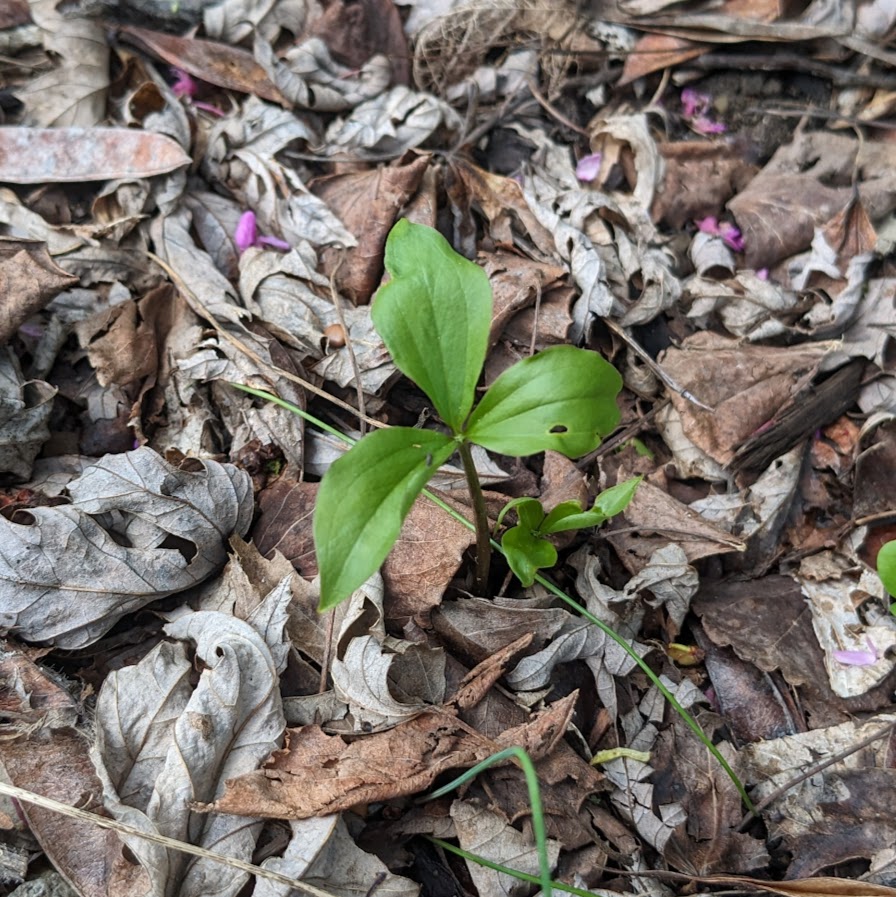
Great White Trillium (trillium grandiflorum) is one of the most beloved spring ephemerals in many areas of the US, including my own state of Ohio where it’s the state wildflower. In this article I’ll share answers to some important questions about growing it based on my own garden experience in combination with the research I’ve done. (And most of it applies to other native trillium varieties as well.)
First, I’ve seen many gardeners worry about the plants not emerging promptly in summer which leads to fears that it has not survived the winter. Even though many perennials are emerging earlier than usual thanks to climate change, trillium grandiflorum appears to still take a bit longer to come up.
In my garden, I had most of the plants in my shade garden out of the ground by April 1 (as well as many summer-flowering plants like coneflowers), but my trillium was still nowhere to be seen.
I was worried it might be dead, but I decided to have patience as I have heard from other gardeners that it likes to take its time and can be late to emerge.
I was thrilled to see it finally poke out of the ground right in the middle of April.
I had planted this trillium in late spring of 2022, and that first year it only lasted a week or two before wilting and disappearing. At that point I was also worried it wasn’t going to survive the rest of the year since it did not have that much time to establish, but I made sure to keep its location watered, especially during dry spells to help protect the rhizome. Trillium naturally goes dormant when temperatures rise, so this is to be expected, and it dutifully returned the following spring, surprising me in the process!
So in your own garden, don’t fret or assume the worst if your trillium is nowhere to be seen well into April (this of course depends on your location, but translate to “several weeks after other spring-flowering perennials and ephemerals” as needed).
This timeline leads to the next questions that most gardeners will have, relating to the length of time that trillium will take to actually flower, and if it spreads reliably after that.
How Many Years Does it Take Great White Trillium to Flower?
The challenge with growing many spring ephemerals in your garden is that it can take multiple years to germinate from seed, and even longer to flower. Great white trillium is no exception.
Trillium grandiflorum can take two years for plants to germinate from seed (and rates are not extremely high either), and after that a full 5-7 years to see the first blooms. This number has wide variations based on a multitude of factors including soil, shade, temperatures and ecoregion, and even just discrepancies in individual populations of plants.
But the stunning white flowers are well worth the wait! And it’s a very worthy plant to include in your garden because its many-year process for maturation causes the more impatient or profit-driven to collect trillium from the wild, which can endanger wild populations.
Does Great White Trillium Spread and Multiply? How Can I Propagate Them?
One of the only things better than a beautiful white trillium flower is, of course, many of them. If you’ve played the waiting game for long enough that they have bloomed, then fortunately you don’t have too much more time to wait until they are likely to start spreading slowly but steadily into larger clumps with multiple flowers.
They may take a very long time to establish, but fortunately trillium is long-lived as well, so with patience you can enjoy your (hopefully growing) patch for many years.
As I’ve mentioned previously, trillium can be grown from seed but that is unreliable and a two-year process. You’re better off planting them in a more naturalized garden where they can freely reseed themselves (ants and other animals also distribute the seeds) in the area, rather than trying to grow from seed in jugs or containers.
They can be propagated by division, but trillium don’t typically handle disturbances well so you need to be extra careful (waiting until they are dormant, digging as much of the root system as possible, keeping watered after planting, etc.).
In my garden, I have my trusty trillium paired with a wide variety of plants from eastern red columbine and sedum ternatum to woodland phlox and wild geranium. It’s shaded by an eastern redbud and a silver maple.
Leave a Reply